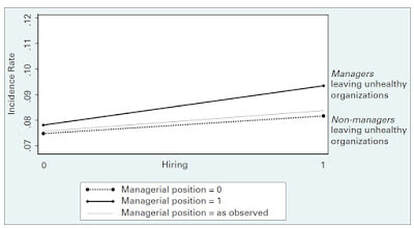 Mental disorders should be taken seriously because a condition such as depression, anxiety, and stress takes a significant toll on those who suffer it and their families, and it affects their work performance. Particularly tragic events occur when stressed operators of hazardous equipment (such as trucks, trains, or planes) make mistakes that threaten safety. The only good thing about mental disorders compared with other diseases is that they are not contagious. Except, asdiscovered in new research by Julia M. Kensbock, Lars Alkærsig, and Carina Lomberg published in Administrative Science Quarterly, they are. Focusing on the workplace, the authors found that mental disorders are contagious. The behavior of a person suffering from a mental disorder affects others by making their interactions and the work more problematic. The end result is that some coworkers end up with the same disorders of depression, anxiety, and stress. This is especially problematic because mental disorders spread through behaviors, so an undiagnosed patient in the organization is particularly threatening as no treatment or adaptation is possible. In a way, this is similar to how patients with contagious diseases can transmit even when they are undiagnosed or asymptomatic. But this is not the worst part of the story. Organizations in which many employees have mental disorders – maybe because they have spread within the organization – become unhealthy, so hiring one of their employees carries a similar risk of hiring mental disorder as hiring an employee who has a mental disorder diagnosis. Of course, unhealthy organizations are exactly the places that employees want to leave in order to escape depression, anxiety, and stress, but they do not realize that they may be bringing it to their next workplace. And there is an even worse part of the story too. To see why, ask yourself who in the organization affects coworkers the most. The answer is obvious – managers do. A manager interacts with many, influences many, and has the power to affect the work and rewards of many others. Hiring a manager with a mental disorder or from an unhealthy organization means that the organization now has a person who is fully capable of transmitting depression, anxiety, and stress to others, and the researcher team found that managers indeed have disproportionately high effects on the mental health of the organization. We already know how the climate of a workplace, and the work done in it, is negatively affected by hiring jerks, especially jerk managers. The damage from having a manager with a mental disorder is similar, or possibly worse. But, the takeaway here is not that organizations should shun employees and managers with mental health disorders. Given their prevalence, trying to do so would have negative consequences for everyone involved. Instead, this research should be a wakeup call for any organization that is not already educating its people about mental disorders and working to improve their mental health. Mental health disorder is a treatable condition (unlike most jerks, I suspect). Given the dangers of contagion, there is no time to waste. Kensbock, J. M., Alkærsig, L., & Lomberg, C. (2021). The Epidemic of Mental Disorders in Business—How Depression, Anxiety, and Stress Spread across Organizations through Employee Mobility. Administrative Science Quarterly, forthcoming. doi:10.1177/00018392211014819 Comments are closed.
|
Blog's objectiveThis blog is devoted to discussions of how events in the news illustrate organizational research and can be explained by organizational theory. It is only updated when I have time to spare. Archives
May 2024
Categories |
 RSS Feed
RSS Feed